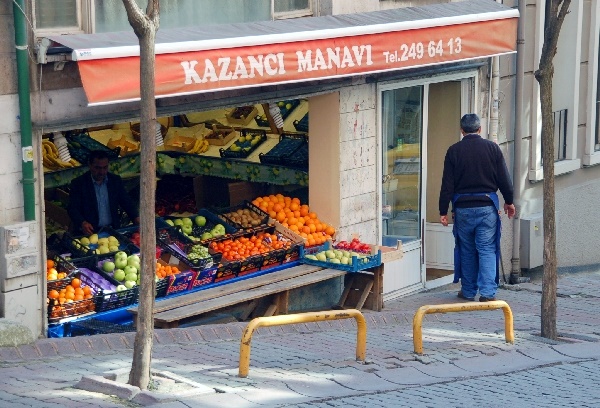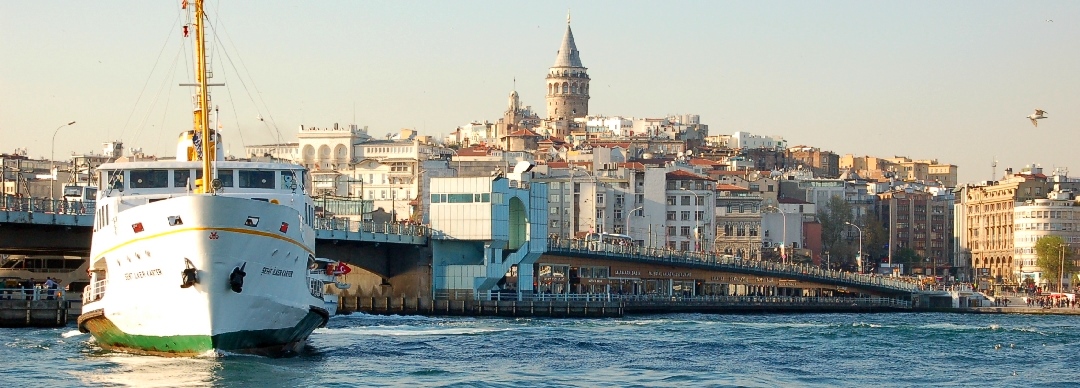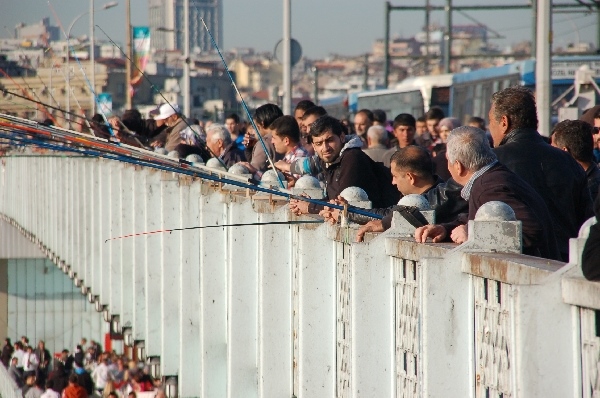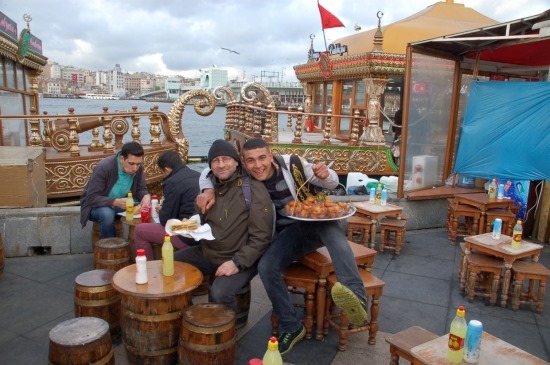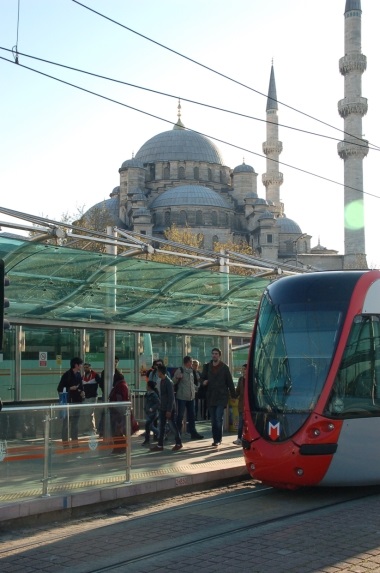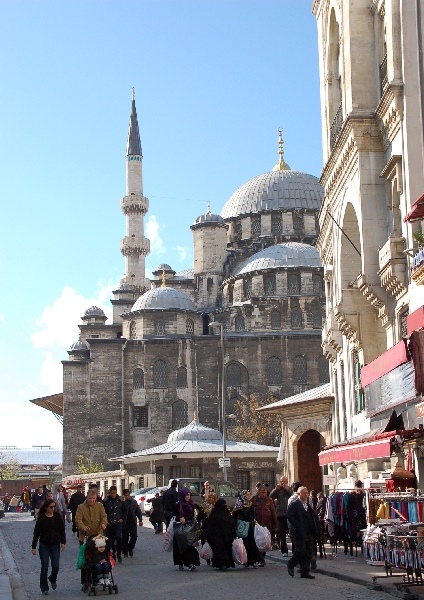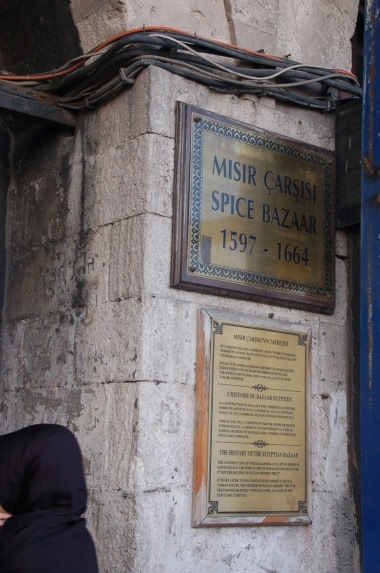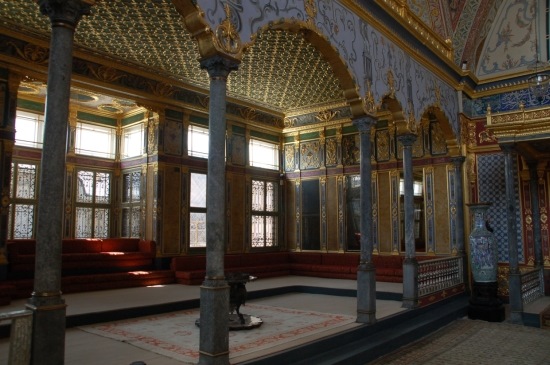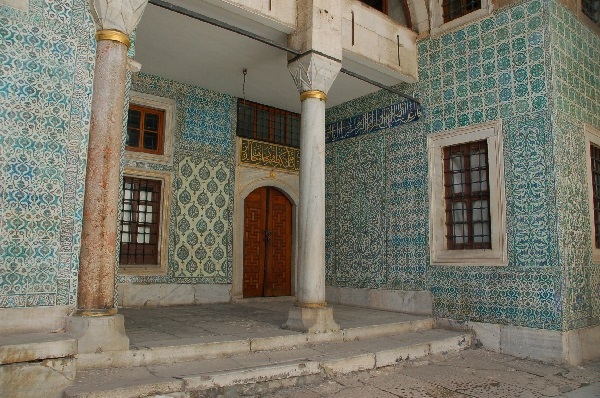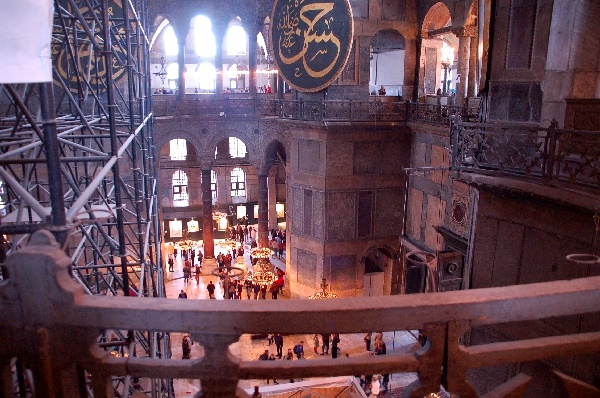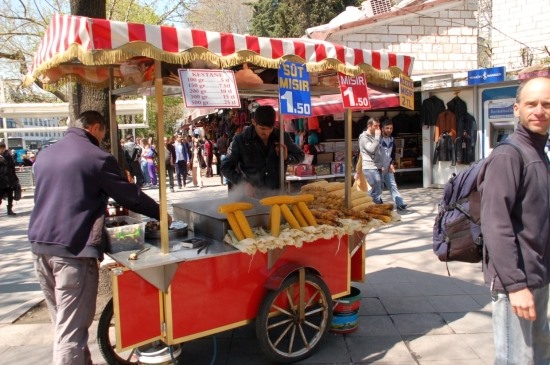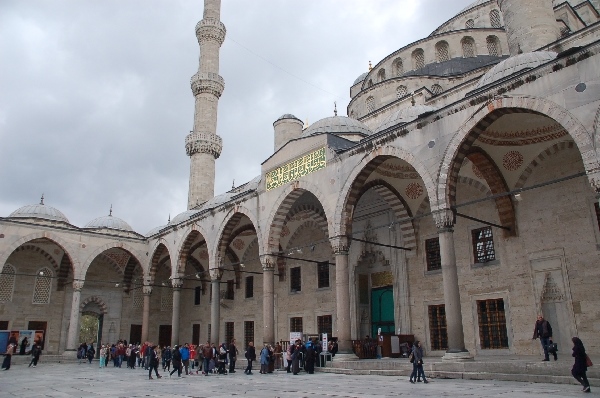World traveler Clown Tom Bolton
Adventure stories & photos

Tom’s trip to Turkey
Istanbul the cultural center of the Byzantin empire
Taksim Square, Istaklal street, Galata
I went to Istanbul, Turkey in April of 2015 for a week. It was kind of a unique situation in that I decided just 2 days before leaving. I had always planned to go to Turkey, especially Istanbul but had never gotten around to it. Then a performer friend of mine mentioned that he was going there for a gig and asked if I wanted to come along. I found that I had to get a visa but it was possible online and done in about 10 minutes. I managed to book the same flights as my friend Pablo but the price wasn’t quite as cheap as he had gotten with more advanced notice.
I tried to book a room in a private house in Istanbul but the woman didn’t respond to the booking request within 24 hours and I then had less than 24 hours till I left, so I took the best concrete offer I found, which turned out to be a hostel rather than a real hotel but they had private rooms. Unfortunately, I had to pay the same price for myself as I would have if I had another person along. The quality of the room Pablo had was much better for slightly more money but was located way out of town near the convention center where he was working.
Taksim square
My place was situated 600 meters down a steep slope from Taksim square, an area belonging to Beyoglu, the region north of the Golden Horn where the main attractions are but was easily reachable from the Findikli tram stop 200 meters further down the hill. Taksim is a large open area where many political demonstrations had been recently held. Towards the southern end of Taksim Square is a war monument, which seemed symbolic of civil strife. Recently there had been many political demonstrations at this central Istanbul location.
Turkey National Day
While I was in Istanbul, Turkey celebrated its National Day. I didn’t see any celebrations or notice anything closed but many buildings had huge flags or like on Taksim, small but numerous ones flying.
Mustafa Kemal Atatürk
Near my hostel was a school where they not only flew the flag but an image of Mustafa Kemal Atatürk who is revered by the populous for having founded the modern republic. The day after the national day, I was in Üsküdar where I saw the stands of various political parties. They were all proud to display lots of flags but also banners of Atatürk although some of them were religious conservatives. Atatürk’s basic premise was to modernize and secularize the country. But he is such an icon that even his ideological opponents want to associate with him as a national symbol while undermining most of what he stood for.
Hotel neighborhood central but not overly commercial
My hostel was centrally located down a steep side street just off of Taksim square. It wasn’t quiet, especially since the windows were poorly insulted but the neighborhood was mixed with shops like many fruit shops. Directly below my accommodation was a Domino’s Pizza. Most of the non-Turkish eateries seemed to be such American chains but were rather rare considering the size of the city. The cost of such a simple room without bathroom was surprisingly expensive. There were shared rooms as well for much less but I had already booked my private room. I felt like having my privacy but might have decided otherwise if I had known that the place was not even half full. There are not so many low budget tourists in April but I had the impression it was a real party scene there during the summer.
Tophane nieghborhood of Beyoğlu
Taksim belongs to Beyoğlu district. Continuing down to the east from my hotel one comes to the water edge and the neighborhood of Tophane. A bit to the north is the port of Istanbul where a cruise ship was docked. Many tourist destinations seemed to get overwhelmed by the cruise ship tourists. Istanbul is so big and full of tourists and so many different sites anyway that I think it is not such a huge impact. Nice to know not all of the tourists one sees are competing for affordable accommodation. Heading south towards the historical center via Galata Bridge one also passes this green building Tophane Kasri. It was built in a traditional English style by William James Smith who also built the English Embassy in Istanbul which became the consulate. It was commissioned by Sultan Abdulmecid as a place to inspect his troops.
Tophane Fountain & Kılıç Ali Paşa Complex
Following the quay to the south one will see the impressive Tophane Fountain or Tophane Çeşmesi on Armory Square. It was built by Ottoman Sultan Mahmud in the 16th century as a public fountain. Behind to the southwest ones sees the huge Kılıç Ali Paşa Complex. This includes a mosque, madrasa (Islamic school) and Haman (baths). It was built by a famous architecture Mimar Sinan and named for Kapudan-I Dargea Kılıç Ali Paşa a 16th Century Italian convert to Islam who became the Grand Admiral of the Ottoman navy. My pictures include a small entrance and the washing area before one enters the main building, which was closed while I was there.
Street tram to Taksim Square, simits a popular snack
Taksim is also the end station for an old historical tram line that runs down the Istiklal shopping street. Here like all over town,
one sees many street carts with simits, a round soft pretzel like pastry for sale. The surrounding area is full of restaurants, hotels and bars clustered around the main pedestrian street of Istiklal where many fancy shops are found. The statue shown is actually near the spice bazaar rather than near Taksim but I thought it best fit here. It shows a simit seller and customer – something iconic enough to immortalize it in bronze.
Greek Orthodox church just off of Istiklal
There are some flower stands at the corner of the square where Istiklal Street begins. I wanted to look in the big Greek Orthodox church just off of Istiklal, seen here in the background, but wasn’t willing to pay the entrance fee since I didn’t know it to have any specific significance. It seemed an open question if churches that didn’t get converted to mosques were still in use or as often, a museum.
Istiklal Street, commercial center
There was at least one other large church along Istiklal street but fronted by a secure gate. The real place of worship now seemed to be commerce with the many shops for the well to do. This is definitely the place for the chic high end stores.
Vendors wearing traditional costumes
There were a couple of shops on Istaklal selling ice cream, water and beer. I don’t know where it started but ice cream sellers in Istanbul tend to wear such colorful vest and caps, costumes from the past. Why them and not vendors of other products other than some fish sandwich sellers? I don’t know. This place also sold water and Efes the local beer. Never tried the beer as it seemed to only be sold in cans, which I hate the taste of – and was relatively expensive.
Sex shops in Istanbul
Not only were there many bars off of Istaklal Street but also an erotic shop. I saw a number of others as well in the city, which surprised me in an Islamic country. They did not show anything suggestive from the outside and I wondered what they actually sold, if it was hardcore stuff or if there were limits. Never did get around to going in such a place to see.
Galata, tower and historical subway
Continuing south on Istaklal, the street ends into a maze of smaller steeper streets near where the nostalgic tram line ends in the neighborhood of Galata. One reaches the medieval stone Galata tower originally known as the tower of Christ, which at the time was the highest tower in Constantinople. I passed it a number of times but either the line to go in was too long or it was after the opening hours. It should give a great panoramic view to the south and the main tourist sites of the old city center. South from Galata tower there are many shops for small souvenirs, small restaurants and the typical Istanbul small grocery store. In this area there was a monument that had a lot of security watching it. No idea why but with so many civil problems with Kurds, Armenians etc. it could have been anything. The picture bottom right looks like any administarive building. It is actually the entrance to the historical Beyoğlu Tünel funicular railway. Seperate from the normal tram system this underground system is the world’s second oldest subway train system.

Galata fish market
Eventually one comes to the coast near the north end of the Galata bridge that connects to the city center. Just west of here is the Galata fish market. Next to the market are a dozen or so small restaurant-cafes specializing in fish and seafood. Most are kind of laid back bohemian places rather than fancy dining. A bit cheaper than some of the more touristy places one can also find stands grilling fish sandwiches like across the bridge for 30% cheaper. This is an ideal are to relax for an evening meal.
Boat supply & repair shops
Beyond the fish market is an area of boat and fishing supply shops and repair shops and salvage. If you are looking for a massive
chain or an anchor, this is the place to find it.
Galata Bridge
The Galata Bridge is a main artery to the city center for cars, trams and pedestrians. It also has a lower level with many restaurants. The bridge is also a very popular place to fish, which made me wonder how often someone on the lower level gets hooked. I also wondered if these establishments get wiped out by the occasional storm surge. The lower level does not continue all the way across the bridge as the middle section is higher to let ferries through. The ferries fly through with less than a meter clearance to the top and each side, which looked like it would be risky in times of rough weather and impassable if water levels rise much.
Eminönü, Spice bazaar, Yeni Cami Mosque
Eminönü
From the other side of the Galata bridge one has a view to the south to the area called Eminönü. There is a tram stop to the east of the bridge and a ferry terminal a bit to the west. Along the water on both sides is a large open area separated from the area further south by a busy multiple lane road.
Along the water front to the west are a number of decorated boats that are used exclusively to grill fish which are made into sandwiches with onion and lettuce in a long roll. The view from the bridge is spectacular with the Rüstem Pasa Cami mosque in the background. The night time views are well worth returning for. The view below right shows both the Yeni mosque in the foreground and the Rustem Pasa Mosque behind on the hill.
Fish boats at Eminönü
Fish fry on boat. Simple grill job when you only have one product but the boats rocked wildly from the waves of every passing boat. One orders and pays for the sandwiches at the boat. There are seats and small stools where one can sit to eat and sellers come around with tea or desserts. There is no big pressure to buy anything in addition and the servers seem to enjoy photo bombing. Also available was juice with fruit cocktail.
Eminönü plaza
One could also walk across the open area away from the water and there was a series of stone steps where one could eat or just watch the people go by. I actually ended up at this spot a number of times. Once there was a duo of musicians playing but I don’t think they got a lot of money as there first row was all street kids who beg on this area. The kids were mostly shoeless although it was cool weather. A play for sympathy I assume as one girl of about 9 also pulled out a nice cell phone to photograph the musicians. The beggar kids were of course themselves the motif for some tourist photographers who were then hit up for donations if spotted.
Eminönü ferry & tram terminals
Next to the fish sandwich boats was the Eminönü ferry terminal. This was a vital hub for transportation as across from the ferries was also the Eminönü tram station, shown here with the Yeni Mosque in the background. I found the public transportation to be excellent and cheap in Istanbul. There are metro and tram lines, buses and a special metro bus that has its own lane to keep it from getting tied up in traffic.
Then there are the ferries. One can buy tokens for 3 Turkish Lira (TL) which gets you on a line and you can go as far as you want – or theoretically ride back and forth without paying more. One needs an additional token to transfer to another line or form of transport. I got the Istanbul card which cost 10 TR, 4 of which was credit. One just passes the RFID card over the reader at the entrance and 2.15 TR is taken off. But if one transfers within a certain time, the next ride is 1.45 and the third 1.15 TR. All major stations had machines where one could buy more credit. Just hold the card on the surface, put a bill in and the credit is added. And for groups, one card can be used for all – just pass it back over to your companion after passing the turnstile. Compared to Stuttgart it is very cheap.
Figuring out the buses was not as easy as the trams so one had to ask around. The trams and metro were well marked with a display showing the upcoming stop so one could hardly go wrong. I took a few ferries which had the disadvantage that some only ran once an hour compared to about every 10 or 15 minutes for the trams. For international travelers it is important to know that the Atatürk Airport is SW of the city center but connected by metro. Flights to Sabiha Gökcen Airport are not as convenient since the metro does not connect that far to the east. There are supposed to be special shuttle buses that can get one into town, more expensive than using the normal public transportation but much cheaper than a taxi. Another perspective of this area shows that it is not just a hub for trams, ferries and pedestrians but a major road thoroughfare as well.
Yeni Mosque
There was a passage under the highway from Eminönü where there was another open area. To the east was the Yeni Camii or New Mosque. The area by the Yeni Mosque was always a bustle of activity. I don’t know what the people in the red stalls were selling but some kind of pieces of paper although I don’t think it was lottery tickets like the guy in the wheelchair. His set up seemed pretty clever. With plastic siding his chair became a weather protected stall in itself. The perspective of the Mosque from outside hardly indicated the beauty of the courtyard once through the door. This was a refuge from the hectic of the surrounding neighborhood.
Yeni Mosque interior
Like many of the large Mosques in Istanbul, it was too big to get in a photo without an extra wide-angle lens and a bit on the dark side. An external flash might have helped but the one built into my camera didn’t bring much at such distances and was often not allowed in many of Istanbul’s older sites. I found the posted tablet interesting. It seems to be a weekly schedule of services.
Near Yeni Mosque
Across from the Yeni Mosque (below left) was a museum I did not get to visit. Originally built as a post office in 1892, it was sold to a bank which gotten taken over by Isbank founded by Mustafa Atatürk and in the 1950’s turned into a museum. Just down the road was the commodity exchange (second below left) – also in a historical looking building. The other photos here were taken right outside the Yeni mosque. It seems rather than the government providing properly for handicapped and old people they allow them to sell lottery tickets instead. I saw multiple wooden stalls for this and was impressed with the ingenuity of the guy in the wheelchair to weather protect himself.
Spice Bazaar
Headed back west past the Yeni Mosque one comes to the Spice Bazaar aka Egyptian Bazaar. The spice bazaar is not to be confused with the Grand Bazaar. Much smaller and covered by a simple tin roof rather than majestic archways it was a place for spices and sweets.
Cats of Istanbul
Right by the bazaar entrance was a place for drinking water, which this cat preferred to drinking water from the ground. Just across was an open market for animal food and supplies. One sees cats all over Istanbul. Many seem to be feral but one often sees piles of dry food or left over bread put out on the street for them. Many looked basically healthy but one wonders if they have thought of sterilization programs, or if they are rather encouraged to keep down the rodent population.
Topkapi palace, blue mosque, Hagia Sophia
Istanbul train station
Going east from Eminönü one comes to the Istanbul train station. It looks old and has the look of being out of an old movie about the orient express but it did not appear to be as large or busy as I would have expected but then I read that it has been basically replaced by a newer station across the Bosporus on the Asian side rather than European side of the city. The old station’s rooms now contain at least a restaurant and a hall where exhibitions of whirling dervishes’ dances are held.
Gulhane Park
Heading up the hill toward the Topkapi Palace is the vast Gulhane Park. Extensive flower beds dominate what was once the lower part of the palace grounds. The park can be used without paying an entrance and while rather empty during the week and possibly due to cool weather when I took this photo, on the weekend it was full of locals strolling around in addition to the tourists. It was popular for locals to have their picture taken in the middle of flower beds, so I was surprised that the plants were not all trampled and none of the security guard seemed to care. From the park, one can see the walls and some of the buildings belonging to the inner part of the Sultans’ palace.
Archeology Museum
There is an upper and lower entrance to get to the Topkapi Palace. The lower one goes through Gulhane Park and up a steep road past the Archeology Museums which are housed in another section of the palace complex. I went on a separate day from seeing the palace and spent over 4 hours there. Below right I am including a photo of the street outside the museum. It was lined by one cafe after another which were chilled-out places for a rest in the midsts of swarms of tourists
There are tens of thousands of artifacts covering the whole region of Turkey its neighbors. It was really overwhelming to try to catch half of the different empires and societies that existed over thousands of years of civilization. Greeks, Romans, Persians, Ottomans; it seems every major world power on that side of the globe set foot in Turkey. Most displays had explanations in Turkish and English including some political statements criticizing the western plundering of Turkish artifacts although they also had plenty of stuff looted from Egypt, Babylon etc. There were audio-phones available that provided commentary in different languages to the more relevant displays. This was also available at the Sultan’s Palace but I passed on spending the extra money.
The Sultans’ Topkapi Palace
Thise is the outer upper entrance to go to the Topkapi Palace in the background. Having accessed either the upper main entrance or the lower one via Gulhane park, one has another entrance and an additional park area and the ticket booths to gain entrance into the inner part of the palace.
There are special museum passes for 3 or 5 days that include the palace and some of the other main attractions. One can buy them at machines here or at the ticket booths. The pass only lets one see each attraction one and doesn’t save much if any money but the big advantage is that once one has the pass, they can skip the lines at the ticket booths wherever it is valid. I had 7 days to see the city and choose not to bother with the pass.
The profile of the people going into the palace was interesting. The majority of them seemed to be Turkish or middle easterners. The western and Chinese visitors were mostly middle aged to elderly. What I didn’t see many of on my trip were young backpacker types, which I assume was due to it being April and not summer vacation time from schools or work.
Inner entrance to Sultan’s palace
These are the fortifications and entrance to go to the inner part of Topkapi palace. The tickets booths are to the right. The price was 30 TL, just over 10 Euro at the time. Within this part, the private quarters of the Sultan his family and concubines known as the harem cost an additional 15 TL. The whole palace complex had at one time housed an estimated population of 5000 including officials and workers.
Palace courtyards
The palace buildings were built around a series of courtyards. I saw a number of people who I assumed to be some kind of Imam and this one had an assistant. I wonder what modern Islamic scholars make of a Sultan? Like European royalty that were often closely associated and supporters of the church and patrons of religious art and the building of places of worship, the Sultans built lots of Mosques and commissioned elaborate Korans and other Islamic artifacts. But what about the abuses of power, enslaving people including women for sex, the obsessive luxury, the killing of hereditary rivals etc.? Were there no conflicts or is it a matter of double standards for the elite with wealth and power like in most societies?
Palace architecture
This was a corner building with a good view to the north. It made me question the use of space. I assume the high arched roofs helped keep a place cool in warm weather but for all of the effort it takes to erect, it doesn’t offer many square meters of usable space. Second or third floors or even lofts were the exception. Like the construction of many of the churches and mosques, I assume it was pure audacity to build something so big just to show you can and to ignore how much land was needed. The concept of bigger is better and flaunting wealth is definitely an age old phenomena. I assume there were exceptions of secret passages but the rooms on the lower level in this photo were not directly connected to the space above. I think such places were often for storage or work space for underlings; like one couldn’t expect royalty to dwell in a cellar.
Artistic tile work & artifacts
I couldn’t always tell if a room was a mosque or just another private royal room but there was mcuh exceptionally beautiful tile work and glizy decoration. The buildings were an attraction in themselves but many are also used for exhibitions of armor, jewelry, Islamic art, and even cookery.
Palace Harem
As befitting a Sultan, the harem had the most elaborate tile work and other fine details and comforts. The harem was a place inside of a palace where the Sultans wives and a limited number of servants had access. One pays extra to see the harem section in addition to the rest of the palace but it was well worth it cost to see the nicest rooms and courtyards.
Hagia Sophia
Situated next to the Topaki Palace is the Hagia Sophia aka as Ayasofya or great Church. Originally built as a church from 532 – 537 A.D. in Constantinople during the reign of the Byzantine emperor Justinian I. It survived the looting of the fourth crusades in 1204 and in 1453 had minarets added as it was converted to a Mosque. Mustafa Atatürk made it into a museum in 1935. It’s considered a gem of historical architecture having used innovative designs and techniques allowing the builders to create one of the largest and highest structures of ancient times.
A number of earlier churches had stood at this spot but fell to strife, fire and earthquakes. Its unique use of domes and archways were often improvised due to technical difficulties during its quick construction and became a model for much of the later style of architecture used for large Mosques. From outside it looks massive but not especially attractive. Part of this was due to extensive re-enforcements needed to keep it from collapsing. This first photo is a view taken from the gardens towards the Blue Mosque. Further views are a ferry on the Golden Horn with the railroad station visible in the foreground. Also seen are images of the gazebo in the courtyard and the entrance and exit (showing the Blue Mosque in the background) .
Hagia Sophia interior design
The interior of the Hagia Sophia is massive but a bit on the dim side for making out details. Some of the photos are filtered to better see teh real colors. In the main part and archways, the architecture with the use of various dome and half domed structures, is an artwork in itself. The changes made when it became a mosque seemed minimal. As a museum they have tried to keep it in good shape and have a few displays and additional artifacts displayed in the foyers. There was a scaffolding set up for renovation work but it only blocked off a small section. I include a number of shots of the main space but from above and below and various closenesses. Also shown is the archway behind the alter area.
Mosiacs & VIP area on upper floors
The upper floor of the Ayasofya was exclusively for top VIPS rather than the masses already from the beginning. The most exclusive part had huge mosaics a few of which are basically intact and some others partially. One has to appreciate that the Muslims would use it as a mosque yet tolerate religious images. At least they didn’t just destroy the images but most that remain had been covered over at some point. There was also a vitrine with just icons of Mary.

Mausoleums of the Sultans
From the upper floor window of the Hagia Sophia ones sees the Sultans’ mausoleums below and the Blue Mosque in the background. This is a close up of one of the 3, or was it 4, mausoleums of the Sultans. They were added to the complex but one can see them for free, the entrance being on the backside. The remains of the Sultans and their most immediate family were interned here.

Near the Hagia Sophia
There is a square dominated by a big flower bed and a series of gardens that separate the Hagia Sophia complex from the Blue Mosque. Near the corner of the square I took the photo of this corn cart, which like the semit pastry carts, are seen all over. The corn is boiled and salted or one can get it additionally grilled for 1.5 TL a welcomed cheap snake since most of the restaurants around the Palace, Hagia Sophia and Blue mosque are there to part tourists from their money. The Sultanahmet tram stop, the major one for most of the main sites is located here, so there is a constant flow of both locals and tourists.
Roman Milion
Across from the square separating the Hagia Sophia and Blue Mosque is the Roman Milion. This obelisk was set as a measuring point during the reign of the Romans from which all points would be measure since Constantinople was considered the center of the known universe at that time. While it is significant that it was later taken by the Ottomans, the sad truth is that corruption and internal fighting was the real cause.
Before the reformation there had already been a major fracture with the Roman Catholic Church to the west and the Eastern Orthodox churches to the east. During the fourth crusade, it was the Romans who actually destroyed and plundered much of Constantinople. It was weakened and, although mistrustful of the help offered from Rome, agreed to bow to their authority to starve off the Ottomans but the help sent was too little, too late. Thus rivalry in the Christian world was as much to blame for the Ottomans ability to spread their influence.
Blue Mosque aka Sultan-Ahmet Cami
The Sultan-Ahamet cami, usually referred to as the Blue Mosque by foreigners is a masterpiece of workmanship although it is not the biggest or most intricately done mosque. Part of its attraction is its location built over the ruins of former palaces it was in a way an answer to the Hagia Sophia nearby as if to say, yeah, we can do that just as well. The courtyard of the Blue mosque is as expansive as the building itself.
Interior of the Sultan-Ahamet cami
The nickname blue mosque comes from some of its interior tile work which uses a lot of blue tones. On the other hand this is not actually unusual but unlike what one would expect from the name, neither the exterior nor exterior are blue.
The supportive columns are something rather unique in their massiveness, something that has been criticized by some as being exaggerated in their purpose to be stable, diminishing the attractiveness. One has to wonder about such criticism, seeing how Turkey is earthquake prone and a collapsed building does not look very attractive, so why not error on the safe side?
It is claimed that a real error was in the building of the 6 minarets which is the same number at the holy Kaaba in Mecca. Supposedly, the architect who was not an Ottoman mistook the word gold for the word six. Yet to have erected golden minarets seems implausible and possibly more pretentious than the number. Also, half a dozen minarets don’t get built over night and one would think the progression of such a prominent project would not go long unnoticed so that such a mistake could be finished. The follow up which I had not heard about while in Istanbul was that the consequence was that the ruler that had commissioned the Blue Mosque pair for another minaret to be added at the Kaaba.
Tom’s trip to Istanbul continues on next page:
So, those were just a few tales from my many travels over the last thirty and something years. I hope you've enjoyed another side of a traveling clown! If you want, write me an email or better yet, book my show or set a link to this website or just state me as the beneficiary of your will!
To book or see more information about Tom's clown show and entertainment, visit one or both of his clown websites:
Clown Stuttgart www.clowntombolton.com
Clown juggler Stuttgart, Gremany www.clown-event.de




